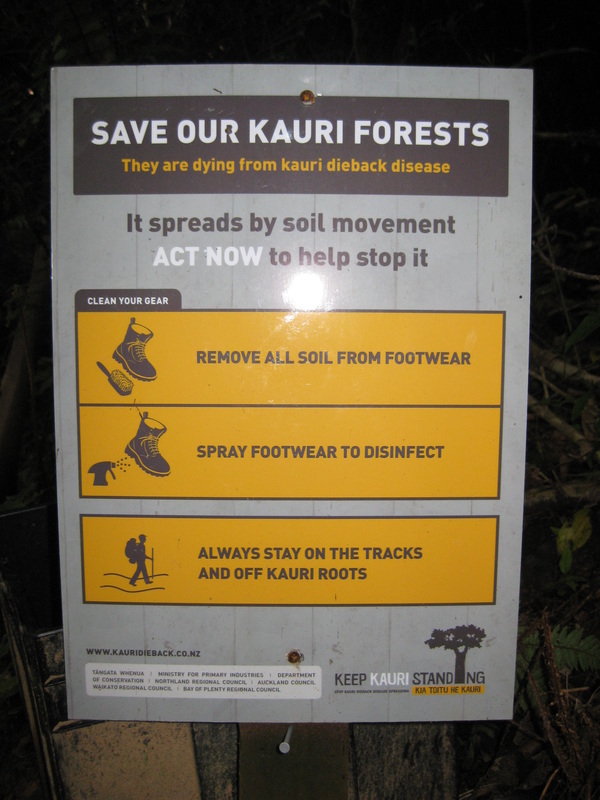Kauri Dieback disease - Phytophthora taxon Agathis (PTA)
|
KAURI DIEBACK THREAT
Kauri dieback is killing our kauri in the Waitakeres, in Northland forests and on Great Barrier Island. Already 11% of the kauri in the Waitakeres have died. The disease was first noticed in the 1970s but was not formally identified until 2008 using DNA technology and samples from infected trees which had been sent to Kew Gardens and put into cryogenic sleep back in the 70s What are the symptoms? Yellowing leaves, thinning canopy, dead branches, trunks bleeding gum. The disease attacks the root system of the tree, starving the leaves and branches. Is there a cure? Not at present. Research is ongoing into a phosphite treatment trial but it is early days. |
How is the disease spread?
By walkers, trampers, mountain bikers, runners, dogs, transferring infected soil.
What can we do to help prevent the spread of PTA?
1. Clean boots before and after using tracks (scrubbing and disinfecting at the cleaning stations).
2. Obey track closures in infected areas.
3. Keep to tracks and away from tree roots.
4. Keep dogs on a leash.
5. Report suspected infected trees to the Kauri Dieback Management Team: 0800 NZ Kauri.
6. If you have kauri on your land, ensure that visitors clean their shoes/car tyres/control dogs.
According to Biosecurity reports, only 50% of people in the forests are using the cleaning stations - do they not understand that if the disease keeps spreading, there will be no kauri forests for our grandchildren to enjoy?
Kauri are not just wonderful ancient trees, they are part of our history and heritage and taonga for Maori. New Zealand's pioneers built an economy based on the kauri timber industry, on kauri gum and amber exports and today our kauri forests are a significant part of New Zealand's tourism industry.
The good news is that kauri in the Hunua Ranges and on the islands of the Hauraki Gulf are still healthy.
We have to help protect our kauri and stop the spread of this disease!
To read more, check out these websites
http://www.kauridieback.co.nz/kauri-dieback
http://www.forestandbird.org.nz/saving-our-environment/threats-and-impacts-/kauri-dieback-disease-help-protect-the-kings-our-forest
By walkers, trampers, mountain bikers, runners, dogs, transferring infected soil.
What can we do to help prevent the spread of PTA?
1. Clean boots before and after using tracks (scrubbing and disinfecting at the cleaning stations).
2. Obey track closures in infected areas.
3. Keep to tracks and away from tree roots.
4. Keep dogs on a leash.
5. Report suspected infected trees to the Kauri Dieback Management Team: 0800 NZ Kauri.
6. If you have kauri on your land, ensure that visitors clean their shoes/car tyres/control dogs.
According to Biosecurity reports, only 50% of people in the forests are using the cleaning stations - do they not understand that if the disease keeps spreading, there will be no kauri forests for our grandchildren to enjoy?
Kauri are not just wonderful ancient trees, they are part of our history and heritage and taonga for Maori. New Zealand's pioneers built an economy based on the kauri timber industry, on kauri gum and amber exports and today our kauri forests are a significant part of New Zealand's tourism industry.
The good news is that kauri in the Hunua Ranges and on the islands of the Hauraki Gulf are still healthy.
We have to help protect our kauri and stop the spread of this disease!
To read more, check out these websites
http://www.kauridieback.co.nz/kauri-dieback
http://www.forestandbird.org.nz/saving-our-environment/threats-and-impacts-/kauri-dieback-disease-help-protect-the-kings-our-forest
